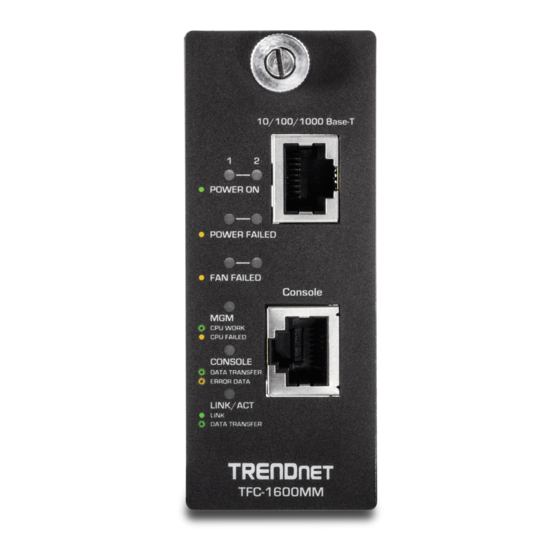Table of Contents
Advertisement
Quick Links
Advertisement
Table of Contents

Summary of Contents for TRENDnet TFC-1600MM
- Page 1 TFC-1600MM Media Conversion System Management Configuring Guide...
-
Page 2: Installing The Management Module
ONFIGURING YSTEM This chapter provides network managers and system administrators with information about how to configure the Media Converter Chassis system. The reader of this document should be knowledgeable about network devices, device configuration, network management, and Internet browsers. The user is assumed to be a network administrator or manager with an understanding of network operations. -
Page 3: Configure Through Web Browser
Configure through Web browser The Media Converter chassis system is accessible using a Web browser (IE explorer, Netscape Communications, etc.) to open up the chassis monitoring system. The default IP Address for the chassis system is “192.168.1.1”, and the default Login name and password is both “root”. -
Page 4: Led Indicators
The default Login name and password is both “root”. Support SNMP Management The Media Converter Management Module supports SNMP management. LED Indicators The LED indicators of the Switch include Power, ALERT, HTTP, ICQ, SMTP, SPEED, LINK/ACT and FDX/COL. The following shows the LED indicators for the Switch along with an explanation of each indicator. -
Page 5: Main Menu
for activity. Management Setting Through Web Browser Main Menu Figure (1) Main Menu System Function There are four items in System Function menu, “Software Reboot, Factory Reset, Image Update and Configuration Update. ( Figure 2) Configuration There are three items in Configuration menu, “General Configuration, System Configuration and SNMP Configuration. -
Page 6: Software Reboot
Figure (2) Configuration 1-1-1 Software Reboot To reboot for the software setting. 1-1-2 Factory Reset This function is to set the device back to the default setting in case of the messy setting. 1-1-3 Image Update Figure (3) The section is to set the TFTP Server IP Address first, and the default address was set to “192.168.1.2”. -
Page 7: General Configuration
Figure (4) The section is expl a ining how to upload and download the configure setting of the module. The Configuration Upload is to restore a setting file to the management module. The Configuration Download is to backup the setting from the management module. 1-2-1 General Configuration Figure (5) - Page 8 1-2-2 General Configuration Figure (6) MAC Address: will show out the MAC address of the device. IP Address: to allocate an IP address for the device, the default IP is “192.168.1.1”. Subnet Mask: to set the Subnet Mask, the default is “255.255.255.0”. Default Gateway: to set the gateway address, the default is “192.168.1.254”.
- Page 9 1-2-3 SNMP Configuration Figure (7) Get Community Name: to get the device community name (default = public) Set Community Name: to set the device community name (default = private) Trap Community Name: to authorize the device trap community name (default = public) Trap Host IP Address: to set the trap host IP address (same as monitoring station IP address)
-
Page 10: System Function
Management Setting Through Terminal Emulator Main Menu Figure (8) System Function There are three items in System Function menu, “Software Reboot, Factory Reset, Image Update. ( Figure 9) Figure (9) 2-1-1 Software Reboot... -
Page 11: Factory Reset
To reboot for the software setting. 2-1-2 Factory Reset This function is to set the device back to the default setting in case of the messy setting. 2-1-3 Image Update Figure (10) The section is to set the TFTP Server IP Address first, and the default address was set to “192.168.1.2”. - Page 12 Configuration Figure (11) There are four items in the Configuration menu, “General Configuration, System Configuration, Media Converter Chassis and Media Converters. (Figure 11) 2-2-1 General Configuration Figure (12) Hardware revision: noted the version of the hardware. BIOS revision: noted the version of the BIOS. Firmware revision: noted the version of the firmware.
-
Page 13: System Configuration
Change Password: the changing of the admit password. Confirm Passw ord: to confirm the setting of admit password. System Name: to authorize the device system name. Location: to show the device where it is located. Refresh time: to set the refreshing time of the device through the web. 2-2-2 System Configuration Figure (13) - Page 14 2-2-3 Media Converter Chassis Figure (14) The screen will show out the power status of the chassis system. V stands for “yes” and X stands for “No”. Plug in: indicates if Power 1 or 2 was plugged in or not. Power Fail: indicates if the Power 1 or 2 is fail or not.
- Page 15 2-2-4 Media Converters Figure (15) Indicates the Link, Duplex mode and Speed status of each media converter.
-
Page 16: Snmp Configuration
SNMP Configuration Figure (16) Get Community Name: to get the device community name (default = public) Set Community Name: to set the device community name (default = private) Trap Community Name: to authorize the device trap community name (default = public) Trap Host IP Address: to set the trap host IP address (same as monitoring station IP address) - Page 17 Appendix A When forgot the password Boot up the chassis system and press the escape button repetitious three to four times, then press “root” for login the BIOS setting, some command key as follow: help, ls(list), sysconf (system configuration), flash, boot Help: to check the usage of the command list.















Need help?
Do you have a question about the TFC-1600MM and is the answer not in the manual?
Questions and answers